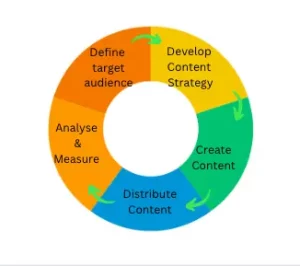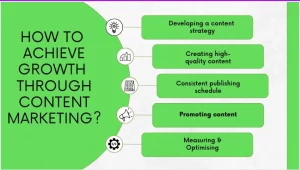30 Unique Content Marketing Ideas
Businesses use content marketing to promote their products and services and engage with their audience. Reports published by Content Marketing Institute states,
- 71% of B2B marketers believe that it is more important for their organisation.
- 40% of B2B marketers prepare their marketing strategy; and another 33% believe to have a strategy, which is not documented yet. There are 27% of people who have no strategy at all.
- Just 29% of B2B marketers say their organisation is extremely or very successful with it.
Let us dive deep into the relevance of content marketing.
What is Content Marketing?
The goal of is to draw in and keep the attention of a target audience by producing and distributing valuable, pertinent, and consistent material. Additionally, it seeks to influence profitable consumer behavior, such as generating leads, raising revenue, and fostering customer loyalty and brand recognition.
A variety of content kinds, such as blog posts, articles, videos, infographics, white papers, e-books, case studies, webinars, podcasts, and social media updates are all part of it. The information should speak to the needs and interests of the target audience while also being instructive, educational, and entertaining.
Also Read: Difference between Copywriting and Content Writing
The Process
The process typically involves the following steps:
Defining the target audience:
Understanding the needs, interests, and pain points of the target audience is crucial to creating compelling content that resonates with them.
Developing a content strategy:
This involves determining the goals of this marketing program, selecting the content types and channels to use, and creating a content calendar.
Creating the content:
You can produce the content in-house or outsource it to a marketing agency. Just stick to the high-quality, informative and engaging content.
Distributing the content:
You can distribute the content through different social media channels and make a permanent audience using email marketing and the brand’s website.
Analysing and measuring the results:
Measure the effectiveness of the this program using analytics. You can create more of the content that performs well for your brand.
It is a powerful tool for building brand awareness, engaging with a target audience, and driving profitable customer action.
Content Marketing-Impact on Ranking and Growth
It can significantly impact a brand’s ranking and growth in several ways. Here are some ways in which content marketing can impact a brand’s ranking and growth:
Boosts SEO:
If you have high quality content that serves information to the audience, it can help you. Provide informative content that targets specific keywords and search queries. Optimise the content for search engines and enhance brand’s visibility in search results. It will lead to increased website traffic and potential customer acquisition.
Marketing through content increase brand awareness:
By creating and distributing valuable and informative content, a brand can establish itself as a thought leader in its industry and increase brand awareness. This can lead to increased visibility, customer engagement, and sales.
Content marketing enhances customer engagement:
By offering useful and relevant information, it can assist a brand in engaging with its target audience. With the audience, this can aid in establishing trust and credibility, increasing consumer loyalty and retention.
Content marketing gives lead generation:
By offering valuable content that entices potential customers to provide their contact information in exchange for the content, it can be a successful tool for lead generation, allowing a brand to create a database of leads that can be nurtured and turned into customers over time.
By producing shareable and interesting material, content marketing can assist a brand in increasing its social media presence. This can broaden the audience for a business, increasing interaction and the possibility of gaining new clients.
By enhancing a brand’s search engine exposure, raising consumer awareness and engagement, generating leads, and expanding its social media presence, it can have a substantial impact on a brand’s ranking and growth.
Content Marketing builds brand reputation with increased awareness:
A brand’s reputation can be enhanced and its authority within a certain industry can grow thanks to the use of it. A brand can become recognized as a thought leader in its field by producing and sharing educational content of the highest caliber, showing its knowledge, and educating its audience. With its audience, this can assist establish credibility and trust, which will improve authority.
Establishing thought leadership is one of the primary ways that it contributes to the reputation-building of a business. A brand may demonstrate its knowledge of the market and establish itself as an authoritative source of information by producing smart, educational content that speaks to the needs of the target audience. By doing this, you may gain a reputation as the trustworthy authority in your field.
Content Marketing helps in establish trust with the audience
By offering useful and educational information that satisfies the needs of the target audience, it may be an effective method for building audience trust.
A brand can build credibility and trust by creating and distributing valuable content that is relevant to its target market. The likelihood that a brand’s audience will trust it and regard it as an authority in its field increases when they see it offering useful information.
By offering content that demonstrates its knowledge and experience, content marketing can assist a business in showcasing its expertise in its sector. This can assist establish a reputation as a reliable and trustworthy source of information, which will win over the audience’s trust.
How Brand Have Achieved Growth in Content Marketing?
Brands have achieved growth through content marketing by utilising various tactics that help them create, distribute and promote high-quality content that resonates with their target audience.
Here are some of how brands have achieved growth through content marketing:

- Developing a content strategy: Brands that have achieved growth through content marketing have typically developed a comprehensive content strategy that aligns with their overall business goals. This involves identifying the target audience, understanding their needs, and creating content that addresses them.
- Creating high-quality content: Successful businesses have also concentrated on producing top-notch content that is interesting, educational, and beneficial to the target market. To meet the varied audience preferences, this entails deploying a range of content formats, including blog articles, infographics, videos, podcasts, and more.
- Consistent publishing schedule: Brands that have achieved growth through content marketing have maintained a consistent schedule. This helps to build an audience and keeps them engaged with the brand’s content.
- Promoting content: Additionally, brands have marketed their content via a variety of platforms, including influencer alliances, paid advertising, email marketing, and social media. This broadens the audience for the content and increases traffic to the brand’s website.
- Measuring and optimising: Successful brands have also measured the performance of their content and optimised it for better results. This involves tracking metrics such as engagement, traffic, and conversions and using the insights gained to improve future content.
Some brand examples who have attained higher share with content marketing:
Red Bull:
Red Bull is an enterprise that entire marketing plan is based on content marketing. They create a variety of content, including videos, articles, and events, all of which are centered on adventure and extreme sports.

Here are some stats that demonstrate the effectiveness of Red Bull’s content marketing:
- One of the most well-liked brand channels on YouTube, Red Bull has more than 10.4 million followers and more than 9.4 billion views.
- Numerous spectacular events, such as the Red Bull Stratos space leap, which received over 52 million views on YouTube alone, were made possible by the company’s content marketing approach.
- Red Bull’s content marketing initiatives contributed 46% of the company’s $7.5 billion in revenue for the year.
- Red Bull has established itself as a lifestyle brand that emphasises extreme sports and adventure thanks to its content marketing strategy. The brand now appeals to a younger, more active market because of this.
Hubspot:
Software for inbound marketing and sales is available from Hubspot. To assist businesses in expanding their online presence, they provide a variety of free tools, training, and services.
Here are some figures to support the effectiveness of Hubspot’s content marketing efforts:
- With over 7 million monthly views and 2.5 million subscribers, Hubspot’s blog is among the most well-liked marketing blogs online.
- By rating as the top inbound marketing platform in G2’s Grid Report, Hubspot has become a leader in inbound marketing thanks to the company’s content marketing initiatives.
- With a reported 70% customer retention rate, Hubspot has likewise employed content marketing to cultivate a base of devoted customers.
- With the company claiming a 32% year-over-year rise in sales in 2021, Hubspot’s content marketing strategy has also contributed to considerable revenue growth.
Coca-Cola:
Coca-Cola’s “Share a Coke” campaign is an excellent example of content marketing. The campaign encouraged customers to find bottles with their names on them, generating buzz on social media and increasing brand loyalty.

Over the years, Coca-Cola has effectively used a variety of content marketing methods. The following four figures show how successful Coca-Cola’s content marketing initiatives are:
- With over 500,000 images shared online using the hashtag #ShareACoke, Coca-Cola’s “Share a Coke” campaign, which allowed consumers to personalise their Coke bottles with their names, increased sales by 2.5% in the United States.
- Through the use of emotional storytelling to engage customers, Coca-Cola’s “Taste the Feeling” campaign generated over 1.5 billion impressions and contributed to a 4% increase in global sales.
- Over 107 million people follow Coca-Cola on social media, and the company’s social media strategy is centred on increasing engagement and producing shareable content.
Airbnb:
The brand uses content marketing to build trust and establish itself as a reputable source of travel accommodations. They produce high-quality guides and articles that offer travellers and potential hosts valuable information.

Airbnb is a brand that has used content marketing to build trust, establish itself as a reputable source of travel accommodations, and connect with its target audience. Here are some statistics that demonstrate the effectiveness of Airbnb’s content marketing efforts:
In order to engage with its target audience, establish credibility as a reliable supplier of travel accommodations, and build trust with consumers, Airbnb has embraced content marketing. The following numbers show how successful Airbnb’s content marketing initiatives are:
- With over 10 million users each month, Airbnb’s site, which offers a variety of travel articles and advice, has established itself as a useful tool for travelers.
- With over $1 billion in revenue in 2019, Airbnb’s “Experiences” platform, which gives tourists the chance to reserve distinctive local experiences, has been a successful content marketing effort.
- With its “Made Possible By Hosts” campaign collecting over 9 million views on YouTube, Airbnb has also employed video material to communicate with its target audience.
30 Unique Content Marketing Ideas
Here are 30 unique techniques for generating content marketing ideas:
- Conduct customer interviews and create content based on their feedback.
- Utilise user-generated content such as customer reviews, social media posts, and images.
- Create an online forum or community to foster engagement and user-generated content.
- Analyse your competitors’ content and identify gaps in the market.
- Use social listening tools to monitor conversations about your brand and industry.
- Leverage data from customer surveys or focus groups to create relevant content.
- Partner with influencers or industry experts to create collaborative content.
- Create quizzes or polls to engage your audience and gather feedback.
- Repurpose existing content into different formats, such as videos, podcasts, or infographics.
- Conduct original research and create content around the findings.
- Use trending news topics to develop timely and relevant content.
- Create how-to or instructional content that addresses common pain points for your audience.
- Use storytelling to create emotional connections with your audience.
- Create a series of related content pieces that build upon one another.
- Use humour or memes to make your content more engaging.
- Create content around special events or holidays that are relevant to your brand.
- Create content that addresses frequently asked questions about your products or services.
- Use customer success stories to illustrate the benefits of your products or services.
- Create content that addresses current industry trends and Google trends and provides insights or thought leadership.
- Create visually stunning content such as virtual tours or 360-degree images.
- Leverage pop culture references or trending hashtags to create shareable content.
- Create an interactive tool or calculator that engages your audience.
- Use case studies to demonstrate the effectiveness of your products or services.
- Create content that addresses common myths or misconceptions about your industry.
- Use the live streaming to create real-time engagement with your audience.
- Create content that showcases your company culture or values.
- Create seasonal content such as back-to-school or summer vacation guides.
- Use data visualisation tools to present complex information in an engaging format.
- Create a series of expert interviews or Q&A sessions on relevant topics.
- Use personalisation to create content tailored to your audience’s interests and preferences.
How to Choose the Best Technique for your Brand?
Here are some tips to help you choose the best content marketing technique for your brand:
- Understand your target audience: Start by understanding who your target audience is, their pain points, and what they are looking for in terms of information and entertainment. By understanding your audience, you can create content that resonates with them and provides value.
- Define your brand’s unique value proposition: Determine what sets your brand apart from your competitors and create content highlighting those unique selling points. This can help differentiate your brand and attract your target audience.
- Choose the proper content format: Consider the format most effective for your target audience. This can include blog posts, social media posts, videos, infographics, podcasts, webinars, and more.
- Focus on quality over quantity: Rather than producing a large volume of content, focus on creating high-quality content that provides value to your target audience.
- Use data to inform your strategy: Monitor the performance of your content using analytics tools and adjust your strategy based on what is working and is not.
- Consider different distribution channels: Identify the most effective distribution channels for your content, such as social media, email marketing, search engine optimization, and paid advertising.
- Stay up to date with the latest trends: Keep up with the latest trends in content marketing and adapt your strategy to stay ahead of the competition.
Following these tips, you can choose the best marketing technique for your brand and build a successful content marketing strategy.
Let us understand how a brand called Zomato generates content marketing ideas. This image below is from one of the recent posts from Zomato.
Brand Case Study: Zomato
Let us understand how a brand called Zomato generates content marketing ideas. This image below is from one of the recent posts from Zomato.

Zomato generates content marketing ideas by using a variety of methods to stay up-to-date with the latest food and dining trends, as well as by gathering insights from their user data. Here are a few ways they generate ideas for their content marketing:
Monitoring industry trends:
Zomato keeps a close eye on industry trends locally and globally. They follow food and restaurant industry news, track emerging food trends and popular dishes, and use this information to generate content ideas.
Analysing user data:
Zomato collects data from user reviews, ratings, and search queries to identify popular cuisines, dishes, and restaurants. They use this data to create relevant and exciting content for their users.
Conducting surveys:
Zomato occasionally conducts surveys of its users to gather insights into their preferences and behaviours. These surveys help them understand what their users are interested in and what content they want.
Collaborating with industry experts:
Zomato works with chefs, food bloggers, and other industry experts to create informative and engaging content. These collaborations help them stay on top of the latest food trends and provide their users with expert insights and opinions.
Brainstorming sessions:
Zomato also holds regular brainstorming sessions to generate new content ideas. During these sessions, they bring together members of their content team and other relevant stakeholders to discuss potential ideas and evaluate them based on their relevance to their users, potential impact, and feasibility.
Conclusion
Content marketing is an essential aspect of any successful marketing strategy. Creating high-quality content that resonates with your target audience can increase brand awareness, drive website traffic, and generate leads. To create an effective content marketing strategy, it’s essential to understand your target audience, define your brand’s unique value proposition, and choose the right content format.
If you are looking for brand marketing goals through content marketing, connect with us via hello[at]noboruworld.com
FAQ
What’s the difference between content marketing and traditional advertising?
In contrast to traditional advertising, which relies on paid advertisements to send a certain message, content marketing focuses on generating meaningful and educational content to engage and educate the audience.
Contrary to conventional advertising, which frequently has a more short-term, sales-driven goal, content marketing strives to establish trust and long-term partnerships.
How can I find the right balance between quantity and quality in content marketing?
The balance between quantity and quality depends on your goals and resources. Prioritise quality content that genuinely serves your audience’s needs, but also maintain a consistent publishing schedule to keep your audience engaged. Test different frequencies to find what works best for your audience and resources.
Is content marketing suitable for all types of businesses?
Content marketing can benefit many businesses, but its effectiveness may vary. It’s most effective for businesses with a target audience seeking information or solutions related to their products or services. However, with creativity and a well-defined strategy, businesses of all sizes and industries can leverage content marketing to some extent.



